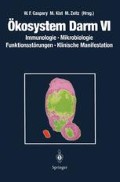Zusammenfassung
Lange ist bekannt, daß nichtsteroidale Antirheumatika (NSAR) Veränderungen der gastroduodenalen Mukosa sowie gehäuft GI-Blutungen bewirken [1, 2, 9, 11–13, 15, 17, 23]. Die morphologischen und funktionellen Schädigungen der Magenmukosa durch NSAR sind insbesondere durch das lokal wirkende Aspirin so eindeutig und reproduzierbar, daß zahlreiche endoskopische Schädigungsscores entwickelt wurden, z. B.
Access this chapter
Tax calculation will be finalised at checkout
Purchases are for personal use only
Preview
Unable to display preview. Download preview PDF.
Literatur
Agrawal NG, Saggioro A (1991)Treatment and prevention of NSAID induced gastroduodenal mucosal damage. J Rheumatol 18 (Suppl 28 ): 15–18
Allison MC, Howatson AG, Torrance CJ, Lee FD, Russell RI (1992) Gastrointestinal damage associated with the use of nonsteroidal antiinflammatory drugs. New Engl J Med 327: 749–754
Bjarnason I, Fehilly B, Menzies IS, Levi AJ (1991) Importance of local versus systemic effects of non-steroidal anti-inflammatory drugs in increasing small intestinal permeability in man. Gut 32: 275–277
Bjarnason I, Hayllar J, Smethurst P, Price A, Gumpel MJ (1992) Metronidazole reduces intestinal inflammation and blood loss in non-steroidal anti-inflammatory drug induced enteropathy. Gut 33: 1204–1208
Bjarnason I, Hayllar J, MacPherson AJ, Russell AS (1993) Side effects of nonsteroidal anti-inflammatory drugs on the small and large intestine in humans. Gastroenterology 104: 1832–1847
Bjarnason I, Smethurst P, MacPherson A, Walker F, McElnay JC, Passmore AP et al. (1992) Glucose and citrate reduce the permeability changes caused by indomethacin in humans. Gastroenterology 102: 1546–1550
Bjarnason I, Williams P, Smethurst P, Peters TJ, Levi AJ (1986) The effect of NSAIDs and prostaglandins on the permeability of the human small intestine Gut 27: 1292–1297
Bjarnason I, Zanelli G, SmithT, Prouse P, De Lacey G, Gumpel MJ et al. (1987) Nonsteroidal antiinflammatory drug induced inflammation in humans. Gastroenterology 93: 480–489
Brooks PM, Day RD (1991) Nonsteroidal antiinflammatory drugs — differences and similarities. New Engl J Med 324: 1716–1725
Davies GR, Wilkie ME, Rampton DS (1993) Effects of metronidazole and misoprostol on indomethacin-induced changes in intestinal permeability. Dig Dis Sci 38: 417–425
Graham DY (1989) Prevention of gastroduodenal injury induced by chronic nonsteroidal anti-inflammatory drug therapy. Gastroenterology 96: 675–681
Graham DY, Smith JL (1988) Gastroduodenal complications of chronic NSAID therapy. Am J Gastroenterol 83: 1081–1084
Griffin MR, Piper JM, Daugherty JR, Snowden M, Ray WA (1991) Nonsteroidal anti-inflammatory drug use and increased risk for peptic ulcer disease in elderly persons. Ann Intern Med 114: 257–263
Hollander D (1993) Permeability in Crohn’s disease: altered barrier functions in healthy relatives. Gastroenterology 104: 1848–1851
Ivey KJ, Rooney PJ (1989) Non-steroidal anti-inflammatory drugs and the gastrointestinal tract. Baillière’s Clin Rheumatol 3: 393–409
Jenkins AP, Trew DR, Crump BJ, Nukajam WS, Foley JA, Menzies IS et al. (1991) Do non-steroidal anti-inflammatory drugs increase colonic permeability? Gut 32: 66–69
Langman MJS (1989) Epidemiologic evidence on the association between peptic ulceration and antiinflammatory drug use. Gastroenterology 96: 640–646
Langman MJS, Morgan L, Worrall A (1985) Use of anti-inflammatory drugs by patients with small or large bowel perforation and haemorrhage. Br Med J 290: 347–349
Madara JL (1988) Tight junction dynamics: is its paracellular transport regulated? Cell 53: 497–498
Madara JL (1989) Loosening tight junctions — lessons from the intestine. J Clin Invest 83: 1089–1094
Madara JL (1991) Epithelia: Biological principles of organization. In: Yamada T (ed) Textbook of Gastroenterology. Lippincott, Philadelphia p 102–118
Madara JL, Barenberg D, Carlson S (1986) Effects of cytochalasin D on occluding junctions of intestinal absorptive cells: further evidence that the cytoskleleton may influence paracellular permeability and junctional charge selectivity. J Biol Chem 102: 2125–2136
McCarthy DM (1989) Nonsteroidal antiinflammatory drug-induced ulcers: management by traditional therapies. Gastroenterology 96: 662–674
Mielants H, Goemaere S, De Vos M, Schelstraete K, Goethals K, Maertens M et al. (1991) Intestinal mucosal permeability in inflammatory rheumatic disease. I. Role of antiinflammatory drugs. J Rheumatol 18: 389–393
Nygard G, Anthony A, Piasecki C, Trevethick MA, Hudson M, Dhillon AP et al. (1994) Acute indomethacin-induced jejunal injury in the rat: early morphological and biochemical changes. Gastroenterology 106: 567–575
Oman H, Henriksson K, Blomquist L, Johannson SGO (1992) Increased intestinal permeability to polysurcrose in NSAID-treated patients. Eur J Gastroenterol Hepatol 4: 235–240
Somasundaram S, MacPherson AJ, Hayllar J, Sarachandra P, Bjarnason I (1992) Enterocyte mitochondrial damage due to NSAID in the rat. Gut 33 ( Suppl ): S5
Spitz J, Hecht G, Taveras M, Aoys E, Alverdy J (1994) The effect of dexamethasone administration on rat intestinal permeability: the role of bacterial adherence. Gastroenterology 106: 35–41
Editor information
Editors and Affiliations
Rights and permissions
Copyright information
© 1994 Springer-Verlag Berlin Heidelberg
About this paper
Cite this paper
Caspary, W.F. (1994). Wirkung nichtsteroidaler Antirheumatika auf die intestinale Permeabilität. In: Caspary, W.F., Kist, M., Zeitz, M. (eds) Ökosystem Darm VI. Springer, Berlin, Heidelberg. https://doi.org/10.1007/978-3-642-85187-2_10
Download citation
DOI: https://doi.org/10.1007/978-3-642-85187-2_10
Publisher Name: Springer, Berlin, Heidelberg
Print ISBN: 978-3-540-58548-0
Online ISBN: 978-3-642-85187-2
eBook Packages: Springer Book Archive

